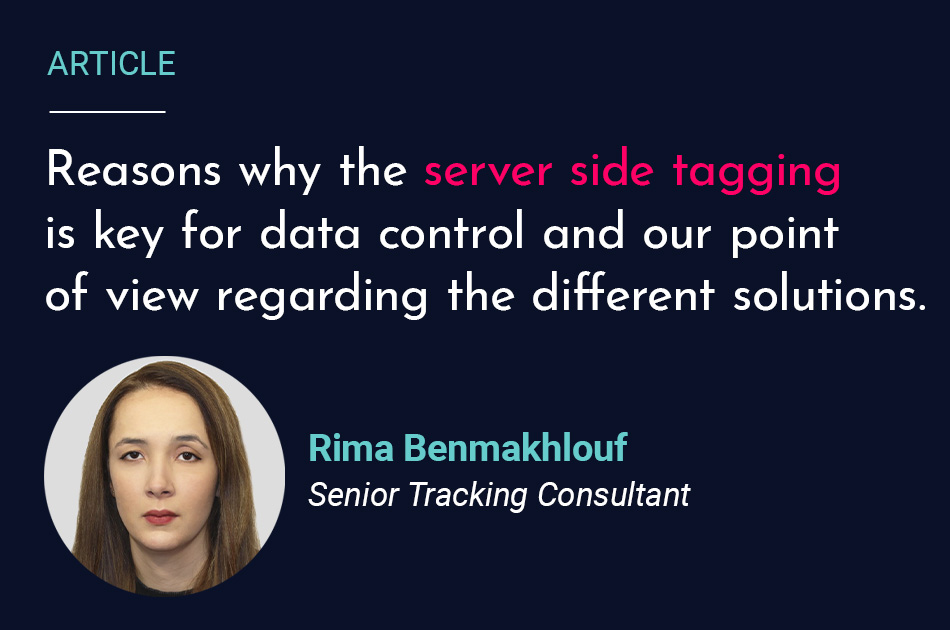Reasons why server-side tagging is key for data control and our point of view regarding the different solutions.
(GTM vs. Tealium iQ vs. TagCommander)
Introduction
For many years, to track users on a specific page, we implemented tags, and we collected data directly from the browser.
Currently tagging is done on the client side, i.e., by users accessing the website. But this has some drawbacks, listed below:
As marketing and legislation evolve, new methods of collecting data are emerging.
Brands need to consider how to collect data in accordance with data protection and privacy.
Server-side is a secure, accurate and controllable solution to track data, as it is not linked directly to the server.
By definition the server, also called client, is “A computer program that responds and returns data to a browser or mobile app”.
For these reasons, the subject of Server-Side Tagging is becoming increasingly important.
We have identified three solutions that can help you overcome tagging issues, Google Tag Manager, Tealium and Tag Commander.
How does the server-side work?
Server-side tagging expresses the launch of a server container in a server-side environment. This new type of solution usually works with the cloud environment.
It allows you to trigger tags from Google, Facebook, or other tools without triggering any third-party code in the web or mobile part.
For instance, when a user arrives on a website and performs a specific action (arrives on a page, clicks on a specific button, or makes a purchase), the client sends the request to server-side to a specific Tag Manager System (TMS).
The TMS receives the information from the client and then the TMS sends information to the server. Finally, the server container tags send selected data to the different tags which send it to the respective tools.


What are the pros and cons of using the Server-side?
The Server side has advantages and disadvantages.
Pros:
Improve the website speed: There will not be many scripts loaded, because the Server is used instead of the browser.
More precise data: The cookies banner, Adblokers, IOS14 has impacted the data collection.
The server-side tracking will allow more precise collection of the data from a campaign. As a result, Google and Facebook and other tools recommend the use of the server-side tracking.
Control of your data: Server-side tagging will help to control the data that each tool receives.
Indeed, when tracking pixels are implemented on a website, it is difficult to control the data that vendors collect. However, with the Server Side, they will only receive the data you send.
Extended cookie lifetime: By using server-side containers in the first party context, it will be possible to extend the expiration time of cookies. However, GDPR compliance is essential.
For Google analytics, it is mandatory to “limit the data transferred. According to the CNIL (Commission Nationale de l’Informatique et des Libertés) it is necessary to follow these steps:
Cons:
Maintenance and Cost: Nonetheless, server-side tracking requires maintenance of the technical infrastructure, which can be very expensive and requires a paid server on a cloud platform.
Server Overload: It is possible that the number of calls on the server will increase, which may affect server load.
Solution under development: Solution is in beta and not completed.
Many vendors have not yet developed server-side implementation solutions.
Difficult check in the recette phase: It could be difficult to debug data that is collected.
Currently, it is easy to check for the tags implemented in the site if the tags are correctly firing with a tools extension like “Omnibugs” or via the “Google Network”.
However, with the Server side it will be more difficult because it is based on IDswhich are hidden from the users.
Tag Management System and Server Side Integration?
The basic configuration is the same for Google Tag Manager, Tag Commander and Tealium which are:
Google Tag Manager
With Google Tag Manager and Google Tag Manager 360, it is possible to implement the Server Side with a dedicated container. The GTM solution is used by many technology companies.
The tags that send data to third-party solutions are no longer on the browser but on a server called a “container server”.
The Server Side’s GTM Container is usually hosted in the Google Cloud Platform and the App Engine Service.
The container server tag receives the data and transmits chosen data to the tags.
Finally, the tags will send this data to the respective vendors.
“Google Cloud Platform offers a monthly credit of $300 free on the Google platform. All customers can use 20+ products for free, up to monthly usage limits”
There are template tags available, Google Ads, Floodlight, UA, GA4 and others created by the community.
On the GTM free version, there is no dedicated support.
Hybrid integration (client side and server side) highly recommended with GTM.
Tealium
Tealium is a tag management tool that allows server-side integration and is used by medium and large technology companies.
Tealium iQ Tag Management is a web interface that is used to implement your tags on the website.
“EventStream is Tealium’s Server-side work module (via the EventStream API Hub or based on a visitor profile in Tealium AudienceStream CDP) that allows you to collect the information that is launched from the web to your server”.
“Tealium Data Hub, is a data collection and delivery solution that processes data by sending one data stream to a cloud-based repository, and then the data is sent to your vendors”.
Connectors are provided, e.g.: Google Analytics, various Facebook connectors, MailChimp etc.
It is important to note that Tealium is a paid solution and it is possible to access a dedicated support team.
A hybrid integration is possible on Tealium.
Tag Commander
TagCommander also allows server-side integration and it is used by small and large technology companies.
There is a dedicated user-friendly interface that permits the implementation of server side tags on Tag Commander.
Moreover, it is possible to use any cloud on TagCommander but no cloud is natively usable on the interface.
With more than 30 Server Side connectors TagCommander’s platform used for server-sideprovides a monitoring dashboard to visualise incoming and outgoing data’.
TagCommander is a paid solution, and to estimate the price you have to contact the provider here for a quote. . It is important to highlight that there is a dedicated support team for the server side integration.
The TagCommander documentation specifically distinguishes between a server-side and a hybrid server-side setup.
Conclusion
In a nutshell, tracking server-side seems to be one of the solutions that will help to overcome the end of cookies.
In fact, this type of tracking enables us to collect data more accurately by improving the performance of websites and to solve many problems that web analysts, traffic managers, and trader media face every day.
However, therewill not necessarily be a total switch to server-side, but rather a hybrid solution between client and server. Indeed, the market technologies are not yet fully stabilised.
It is important to highlight that there is not yet a final solution to the ‘cookieless’issue, and the various market players (ad tech, advertiser, publisher…) are still in a testing phase.
Therefore, it is important to keep an eye on this new product and to be prepared for future changes.
At Artefact, we are constantly looking for new solutions to help our clients in the changing market. Depending on your needs, we can advise you and help you with the implementation of the server-side. We have teams with different expertise (analytics, tracking, data engineering.) that can help you in this type of implementation.

 BLOG
BLOG






